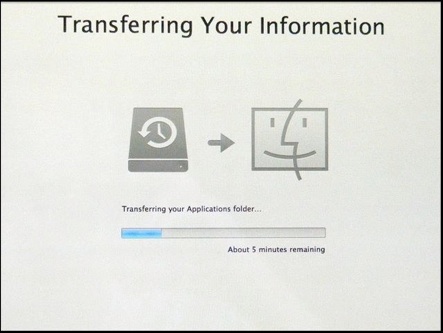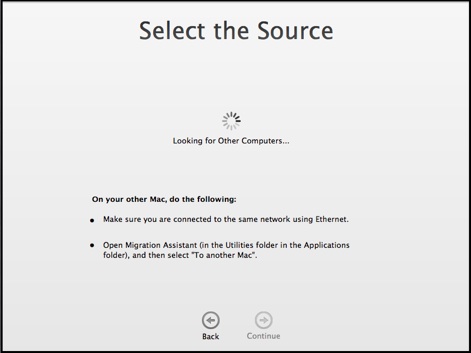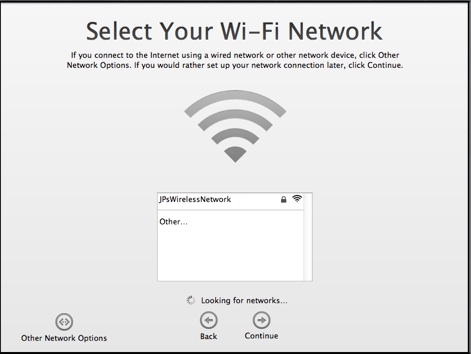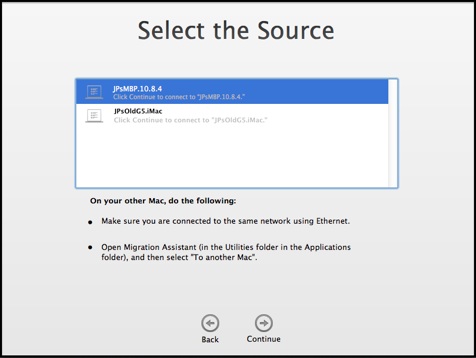OSX Tips: Setting-up a new Mac from an old one, its backups, or a PC
Using Setup Assistant on Mountain Lion or Lion
OSX Tips: Setting-up a new Mac from an old one, its backups, or a PC
Using Setup Assistant on Mountain Lion or Lion
Transferring User Accounts

To select from multiple user accounts, or to select/omit data within one or more, click the "disclosure triangle" in front of the checkbox to see a list of them. (It may take a few moments for the triangles to appear).
For each user you select, you can click the disclosure triangle and select or omit the contents of that user’s top-level folders (Desktop, Documents, Downloads, etc.)..
Otherwise, you can’t "pick and choose" within any of those folders.
Next is the selection for what you want to transfer. You'll see four checkboxes; some will have "disclosure triangles" (they may not all appear until the "Calculating..." is done) you can click to expand that section (see the pink boxes below for details):

•Applications
•Settings
•Other Files and Folders
(The Transfer button won’t be enabled until it finishes "Calculating" the sizes.)
These are mostly "all or nothing" selections.
In most cases, just leave everything selected and click the Transfer button (as soon as it completes calculating all the sizes).
Setup Assistant will then transfer everything selected.
(If you backed-up multiple OSX partitions, or have done a full system restore, the volume name in the sample, just below the title, will be a "pop-up" menu where you can select the one you want.)

That will take a while, of course, depending on how much data is being transferred, and how. (Network transfers will be slower than FireWire, etc.)
When it finishes, if you didn't transfer settings, you'll see windows to set up your network, select a Time Zone, and depending on the circumstances, you'll see one or more other windows about registration (you can skip it), the software license and (if it's a new purchase, the hardware warranty), but eventually you'll actually be logged-on and ready to go!
For each account selected, the default folders created by OSX (Desktop, Documents, etc.) are all transferred automatically, whether you select them or not. Only the folders that are checked will have their contents transferred.
The exception is the user’s Library folder, which isn’t listed. It, and all of its contents, will be transferred along with the user account automatically.
Transferring Applications
This option will transfer applications only from the top-level Applications folder; not an Applications folder(s) in user home folder(s), or elsewhere. It will also transfer various support files in the top-level Library folder.
You must transfer either all apps or none; you can't select or omit them individually (see Transferring Applications for an explanation).
But Setup Assistant will only transfer apps that don't already exist in the top-level Applications folder on the destination Mac; thus the new Apple apps that came with your new Mac will not be replaced by old ones (and the size shown may be very small). But if the names are different, or they're in different places on the destination (such as sub-folders within Applications or elsewhere), you'll end up with both.
In some cases, there may be a few exceptions:
•Some 3rd-party apps may not work properly, or at all, if transferred from an older version of OSX. Check with the maker about compatibility.
•PPC apps transferred from a PPC or Snow Leopard Mac will not work on Lion. They'll be shown with a prohibited overlay (a white circle with a line through it).
•You may have to re-enter serial numbers/purchase codes for some 3rd-party applications.
•Some complex 3rd-party apps that were installed with special installers may need to be reinstalled from the original disc(s) to work properly. Adobe apps are often subject to this.
Transferring Settings
If you're already connected to a network, you won't have the Network option.
If the Computer settings are transferred, that includes system-wide settings, such as Time Zone, System Keychain, EnergySaver, Time Machine, and Sharing. Sharing includes the Computer Name. That's easily changed after your new Mac restarts, via System Preferences > Sharing.
If you're using Time Machine for backups, and want old backups to be treated as if they were made from the new or erased Mac, be sure to transfer Settings. When you do the first backup of the new or erased Mac to the old backups, you'll be asked if you want to "inherit" the old backups. See item #B5 for details.
Transferring "Other files and folders on <disk name> <Computer Name>"
This will transfer the following:
•Non-system files/folders at the top level of the disk, such as the (empty) Unix Desktop folder, the User Guides and Information alias, the Developer folder (if installed), etc.
•The Shared user folder
There is special handling for duplicates in this category: if the item already exists, the new one will have "(from old Mac)" appended to its name.
If you use Time Machine, as soon as your Mac starts up again, turn Time Machine OFF. If it’s already started a backup, cancel it. Unless you back up to the old Mac's backups, the first backup will be of everything. And if anything didn’t transfer properly, it may be more difficult to recover if a new backup is completed.
If you back the new Mac up to the old Mac's backups, when the first one starts, you should get a prompt about using a different Mac's backups. See: Would you like to inherit the backup . . .? The first backup may be a full one, or TM may say it's going to be a full one and run very, very slowly, but only do an incremental backup.

Select the disk you want here.
(If it's not shown, connect the drive, or click Select Network if it's on your network).
If there are both local and network volumes, what's shown for them may be a bit hard to decipher:
•Internal disks have gray icons.
•External disks have green or yellow icons.
•Network disks have blue icons.
Internal or External Time Machine backups show the name of the volume and computer that was backed-up, not the one they're on.
Encrypted Time Machine backups (4th on the sample) show a gray icon, the name of the disk they're on, and ". . is locked. Click to unlock." Click it to enter the password. Once unlocked, it will be displayed normally, but may change position and you may have to re-select it.
Clones show the name of the volume they're on, and the name of the Mac that was backed-up.

(Note: if there are multiple network disks/partitions, the number of backup sets may appear under the wrong one. If so select that wrong one.)

Select the one you want (even if there's only one) then click the Continue button.
Note: if no disks appear after a long time, but the Continue button is enabled, click the button anyway. Check the user names, etc, on the next screen carefully to be sure you got the right one.

Then you’re asked if want to transfer information to your new Mac, followed by four options:
•From another Mac
•From a Windows PC
•From Time Machine or other disk
•Don't transfer now (usually NOT a good idea).
This is the window referred to in the blue box above. Selecting a transfer option changes the Finder icon to a diagram of the transfer.
What you see and do next depends on which option you selected:
•From Another Mac (ie, via your network): the Select the Source window in the tan box below.
•From another Disk (ie, a Time Machine backup, clone, or Mac in Target Disk Mode), the first Select the Source window below this box.
•From a Windows PC a Select the Source window similar to the one below this box, but with instructions to download, install and run the Windows Migration Assistant (you may have already installed it above). Then follow the on-screen instructions. See OS X Lion: About Windows Migration Assistant for details.
Setup Assistant is designed to transfer all or selected data, apps, etc. from one Mac, its Time Machine or "clone" backups, or a PC to set up a new Mac just like the old one.
Migration Assistant, however, is used primarily to transfer user account(s) and perhaps other things, from one Mac, its backups, or a PC, adding them to a Mac that's already set up. If there's any doubt about which you need, see: Setting up a new Mac from an old one, its backups, or a PC.
If the old Mac has any user home folders on a separate disk or partition, and/or you want to set the new one up that way, see: Transferring Home Folders not on a Startup volume.
If the Mac you’re setting up is running 10.5.x or 10.6.x, see Using Setup Assistant on Snow Leopard or Leopard. It's a bit different from the Mountain Lion and Lion version covered here. (If you're not sure what version of OSX you're running, click here).
If the old Mac is on Tiger (10.4.x), you can transfer to Lion, but not via network; only via FireWire or a "clone" backup. You cannot transfer from Tiger to Mountain Lion at all.
"Second chance" to use Setup Assistant
Normally, you only get one chance to use Setup Assistant -- when your new Mac first starts up. If you missed the opportunity, see the green box in Problems after using Migration Assistant for details and instructions.

Both Macs should already be connected to your network, or directly to each other via Ethernet.
Avoid connecting either via WIFI if at all possible.
Set the old Mac to never sleep, then start the Migration Assistant app (in its Applications/Utilities folder). Enter an Admin password for that Mac when prompted, then select the To another Mac option.
You'll see a series of windows with instructions to connect the two. They should be fairly clear, but if you want the gory details, see Connecting via your Network.
If there's an incompatibility, you'll see a message on this screen (of the new Mac) to update the version of Migration Assistant on the old Mac.

When you first start your new Mac, you'll see a screen to select your country, then one to select your keyboard.
If your new Mac is not connected to the Internet via an Ethernet cable, you'll get this window to select your WIFI network:
If you don't intend to use WIFI, or want to set up your network later, select Other Network Options. Of course, that may mean you can't transfer from your old Mac via network.
The following samples are from Mountain Lion; if you're migrating to Lion, the windows look a bit different, but work the same way.
Almost always, folks are transferring from an "old" Mac to a "new" one, so that's how they're referred to below.
Don't be alarmed by the length of this page: It includes many details that only a few users will need, in a few situations. The usual procedure is actually simple:
•Start your new Mac, select your country and language.
•Specify if you want to transfer directly from your old Mac, its backups, or a PC; and connect to it (see the blue box for details).
•Confirm what you want to transfer (Apps, User Accounts, Settings, etc.).
•Wait while your Mac does all the work (copying your stuff).
•When it's done, you're in business!
See below for step-by-step instructions, including some unusual circumstances.
Before you get started:
•There's a brief video demonstration of using Setup Assistant to transfer from Time Machine backups about 3/4 of the way through the Time Machine Tutorial.
•If you anticipate an issue with iTunes authorizations, see About iTunes Store authorization and deauthorization.
•Decide how you're going to transfer (it may not be as simple as it seems):
Three ways to transfer from a Mac or its backups:
Which is best for you depends on your hardware and circumstances. You'll also select different options when you see the Transfer Information to this Mac window below. Follow the instructions in the blue box there. But be careful to select the right option, as you might end up transferring wirelessly (not recommended) when you tried to do it directly!
•If both Macs have Firewire or Thunderbolt ports: connect directly via cable.
This is usually fastest and most reliable.
FireWire: if one is FireWire 400 and the other is FireWire 800, you can get an inexpensive adapter, or a cable with a F/W 400 plug at one end and a F/W 800 plug at the other.
On the Transfer Information to this Mac window, select From Another disk (not another Mac).
•If you have Time Machine or "clone" backups:
•on an external HD: connect it to the new Mac.
It's usually simpler and faster to transfer from them, rather than directly from the old Mac (and, to transfer directly, you may have to install/upgrade software on the old Mac).
On the Transfer Information to this Mac window, select From Another disk.
•Time Machine backups on a Time Capsule: use another option if possible. If not, connect via Ethernet cable if at all possible.
It's usually faster to transfer directly from the old Mac via FireWire or Thunderbolt as above, if possible.
On the Transfer Information to this Mac window, select From Another disk
•To transfer via network (Ethernet or wireless)
Ethernet is 2-3 times faster and much more reliable than WIFI.
They can each be connected to your network via Ethernet or WIFI (not recommended), or use a single Ethernet cable to connect them directly to each other. A direct connection is probably best, since you can't use either one for anything else.
Make sure OSX on the old Mac is the most recent version (via Software Update or the App Store), and that it has a Computer name in System Preferences > Sharing. Disable system sleep via System Preferences > Energy Saver on both Macs.
If it's Snow Leopard, be sure it has the Migration Assistant for Mac OS X Snow Leopard update.
If it's Leopard, be sure it has the Migration Assistant for Mac OS X Leopard update.
If it's Tiger or earlier, you cannot use your Network. Either use Firewire (above), or make a "clone" backup on an external HD and use From Another disk.
On the Transfer Information to this Mac window, select From Another Mac.
To transfer from a Windows PC you must connect them via your network.
Download and install the Windows Migration Assistant on the PC.
On the Transfer Information to this Mac window, select From a Windows PC.

Both Macs should see a window with a passcode; if they match, click Continue on the new Mac. If in doubt, see Connecting via your Network.
Then you'll see the Transfer Your Information window below.